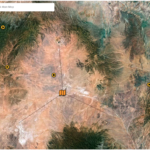The U.S. National Science Foundation National Radio Astronomy Observatory (NSF NRAO), in partnership with several leading Mexican universities and research institutes, has announced a series of landmark agreements and meetings aimed at advancing Mexico’s role in the Next Generation Very Large Array (ngVLA) project.
Recent News
Astronomers Discover a Superheated Star Factory in the Early Universe
Astronomers have uncovered a previously unknown, extreme kind of star factory by taking the temperature of a distant galaxy using the ALMA telescope. The galaxy is glowing intensely in superheated cosmic dust while forming stars 180 times faster than our own Milky Way.
Astronomers Share Largest Molecular Survey To-date: GOTHAM Legacy Data Goes Public
Astronomers in the “GBT Observations of TMC-1: Hunting Aromatic Molecules” research survey, known as GOTHAM, have released a spectral line survey with largest amount of telescope time ever conducted, charting more than 100 molecular species only found in deep space.
The VLA in pictures and video
The National Radio Astronomy Observatory recently unveiled two great resources for learning more about the Very Large Array (VLA). Watch the video below, then head on over the to The VLA Explorer for a thorough tour of the VLA facilities!
Welcome to central New Mexico where the National Radio Astronomy Observatory operates the world’s most versatile radio telescope, the Karl G. Jansky Very Large Array. Here, we have put together a collection of exclusive video tours we call the VLA Explorer.
Recent News
NSF National Radio Astronomy Observatory and Mexican Institutions Sign Historic Agreements to Advance ngVLA Collaboration
The U.S. National Science Foundation National Radio Astronomy Observatory (NSF NRAO), in partnership with several leading Mexican universities and research institutes, has announced a series of landmark agreements and meetings aimed at advancing Mexico’s role in the Next Generation Very Large Array (ngVLA) project.
Astronomers Discover a Superheated Star Factory in the Early Universe
Astronomers have uncovered a previously unknown, extreme kind of star factory by taking the temperature of a distant galaxy using the ALMA telescope. The galaxy is glowing intensely in superheated cosmic dust while forming stars 180 times faster than our own Milky Way.
Astronomers Share Largest Molecular Survey To-date: GOTHAM Legacy Data Goes Public
Astronomers in the “GBT Observations of TMC-1: Hunting Aromatic Molecules” research survey, known as GOTHAM, have released a spectral line survey with largest amount of telescope time ever conducted, charting more than 100 molecular species only found in deep space.

